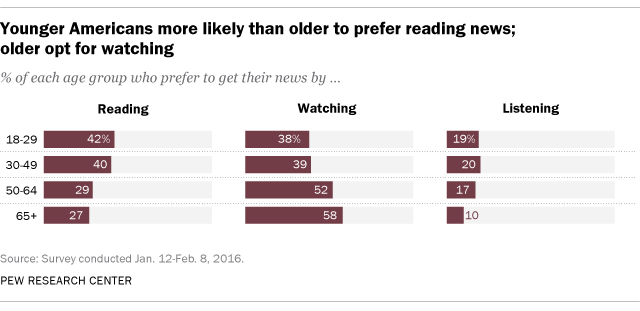Digital publishers may be pouring time and energy into cranking up their video operations, but for a lot of their potential viewers, text is still the way to go.
New data from Pew Research finds that, when it comes to the news, younger adults still prefer words over moving images. While 46 percent of Americans overall say they prefer to watch the news over reading it, that number is far lower for Americans between the ages of 18 and 29 — only 38 percent of that group named video as their preferred news consumption format. In contrast, 42 percent said that they actually prefer text (which they prefer to read online, of course). Just 19 percent of young adults named listening as their preference. (“Smelling the news” was not an option.)

Those preferences put young people at odds with those between 50 and 64 and those over 65, of which 52 percent and 58 percent, respectively, said they prefer to watch the news. Less than thirty percent of people in both those age groups said the same for text.
These generational gaps in news consumption preferences join similar findings from back in July, when Pew reported that 54 percent of 18- to 29-year-olds said that they prefer to get their news online — significantly higher than, say, the 38 percent of those ages 30 to 49, or the 15 percent of those ages 50 to 64 who said the same.
The lack of unhindered enthusiasm among young people for watching news online is probably sobering for digital publishers, many of which are eyeing video as a way to escape their reliance on display advertising, which seems in irrevocable decline.But the challenges facing digital news video have been clear for some time. Oxford’s Reuters Institute for the Study of Journalism found in July that people don’t exactly flock to video when big news stories hit: “So far, the growth around online video news seems to be largely driven by technology, platforms, and publishers rather than by strong consumer demand,” Antonis Kalogeropoulos, one of the report’s authors, said in a statement at the time.
One comment:
I don’t want video blaring when I am at work or on the bus, etc. And I don’t want my device choking on some streaming video or eating my data plan…when all I want are the facts. Almost every device I have has some issue with speed, processor, memory, or internet connection that converts that video into a stuttering, incoherent mess.
And I don’t really want the news coming from some bimbo or stuffed suit, when I can read it for myself. Those talking heads are usually just reading it from the same source…just give me the text. OR, they are in some yelling battle that I can barely distinguish the takeaway content. So NO, from a 50yr old techie…I don’t want the video. By the way, I can mute my speakers and some website will come up with video that auto-plays AND UNMUTES MY SPEAKERS…thus getting me in trouble with my boss when all I was trying to do was check the headlines, or weather, or scores quick.
Trackbacks:
Leave a comment